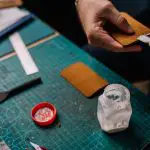Do you ever find yourself staring at the paint aisle, wondering which type of paint is best for your next project? When it comes to painting on fabric, it can be especially confusing. Should you use acrylic or fabric paint? What’s the difference?
The answer lies in the properties of each type of paint, and understanding those differences can help you achieve the best results in your project. Acrylic paint is a water-based paint that is commonly used for painting on many surfaces, including canvas, paper, wood, and even fabric. It dries quickly and is known for its durability and versatility.
Fabric paint, on the other hand, is specifically formulated to be used on fabric surfaces and has properties that allow it to bond with the fibers of the fabric, creating a long-lasting finish. Both types of paint have their own unique characteristics, so it’s important to understand the differences before you start your next painting project.
Table of Contents
Overview of Acrylic Paint
Acrylic paint is a versatile medium that can be used on a variety of surfaces. It’s made up of pigments suspended in an acrylic polymer emulsion, making it water-soluble and fast-drying. This means that artists who want to work quickly and layer their paintings without the risk of colors bleeding into one another will find it perfect.
One of the benefits of using acrylic paint is its ability to be mixed with other mediums. For example, you can add a medium to the paint to make it more transparent or to give it a glossy finish. Acrylic paint also comes in a wide range of colors, from bright and bold to muted and subdued.
Additionally, you can use acrylic paint on a variety of surfaces such as canvas, paper, wood, and even fabric. When it comes to using acrylic paint on fabric, the process is slightly different than using it on other surfaces. It’s important to pre-wash the fabric to remove any sizing or coating that may be on it. Then, you can apply the acrylic paint directly to the fabric using a brush or a sponge. Once the paint has dried, you can heat-set it with an iron to make it permanent. This makes acrylic paint a great option for fabric painting projects.
Overview of Fabric Paint
You’ll love how fabric paint transforms your plain fabrics into vibrant works of art! Fabric paint is specially designed to adhere to fabrics and withstand washing. Here are some key things to know about fabric paint:
-
Fabric paint comes in a variety of types, including traditional acrylic-based paints, puffy paints, and fabric markers. Each type of paint has its own unique properties and is best suited for different projects.
-
Fabric paint can be used on a wide range of fabrics, including cotton, silk, polyester, and even leather. It’s important to choose the right paint for the type of fabric you’re working with to ensure the best results.
-
When using fabric paint, it’s important to follow the manufacturer’s instructions carefully. Some paints need to be heat set with an iron to ensure they don’t wash off, while others can be air-dried.
-
Fabric paint can be used to create a wide range of designs, from simple patterns and shapes to intricate works of art. Whether you’re looking to customize a t-shirt, decorate a tote bag, or add some flair to a piece of home decor, fabric paint is a versatile and fun way to express your creativity.
Differences in Application
Get ready to elevate your fabric painting game with these tips on how to apply the paint like a pro!
One of the main differences between acrylic and fabric paint is how they’re applied. Acrylic paint is thicker and may require a bit more effort to apply evenly on fabric, while fabric paint is specially formulated to be applied on fabric, making it easier to apply and control.
When using acrylic paint on fabric, it’s recommended to mix it with a fabric medium to ensure it adheres properly and doesn’t crack or peel off. Also, it’s essential to use a brush or sponge specifically designed for fabric painting to prevent the paint from bleeding or spreading unevenly. Keep in mind that acrylic paint may take longer to dry on fabric, so be patient and avoid touching the painted area until it’s completely dry.
Fabric paint comes in various forms such as spray, squeeze bottles, or markers, making it easier to apply on fabric without the need for additional tools. Additionally, fabric paint is designed to be long-lasting and flexible, so it won’t crack or peel off even after multiple washes. With fabric paint, you can easily create intricate designs, lettering, or patterns on fabric, making it ideal for customizing clothing or home decor items.
Durability
If you want your painted fabric to last many washes and wears, it’s important to consider the durability of the paint you choose. Acrylic paint is known for its durability and ability to withstand wear and tear. Once it’s dry, it becomes a tough and flexible layer that can resist fading, cracking, and peeling. This makes it ideal for painting on fabrics that will be frequently washed or worn, such as t-shirts, jeans, and canvas bags.
On the other hand, fabric paint is specifically designed to adhere to fabrics and withstand frequent washing. It’s formulated to be more flexible and less likely to crack or peel, which makes it a great choice for painting on stretchy fabrics like knitwear, as well as on fabrics that will be exposed to moisture, such as swimwear and raincoats. Fabric paint is also available in a wider range of colors and finishes, including glitter and metallic, which can add a unique touch to your fabrics.
Overall, both acrylic and fabric paint can be durable options for painting on fabrics, but it’s important to choose the right type of paint for your project. If you’re painting on a fabric that will be frequently washed or worn, acrylic paint is a great choice. If you’re painting on a stretchy or moisture-prone fabric, or if you want a wider range of color and finish options, fabric paint may be a better option for you.
Regardless of which type of paint you choose, be sure to follow the instructions carefully to ensure the best results.
Mixing and Blending
Let’s explore how to mix and blend different colors of paint to create unique shades and effects on your fabric. Mixing and blending paint is one of the most exciting aspects of painting, and it requires some practice to get the hang of it. Here are a few tips to help you get started:
-
Start with the primary colors: Mixing red, yellow, and blue paint will give you all the colors you need to create any shade you want. By combining these colors in different proportions, you can create a wide range of secondary and tertiary colors.
-
Be mindful of the paint consistency: When mixing paint, it’s important to pay attention to the consistency of the paint. If the paint is too thick, it’ll be difficult to blend, and if it’s too thin, it’ll be hard to control. Add water or a fabric medium to adjust the consistency of the paint.
-
Experiment with different techniques: Different paint techniques will give you different results. You can try mixing paint on a palette or directly on the fabric. You can also try blending colors with a brush, sponge, or even your fingers.
Mixing and blending paint is a fun and creative process that can add depth and dimension to your fabric painting. With some practice and experimentation, you can create unique shades and effects that’ll make your artwork stand out. So go ahead and explore the wonderful world of paint mixing and blending!
Cost and Availability
If you’re looking to purchase acrylic or fabric paint, it’s important to consider the cost and availability. Acrylic paint typically ranges from $5 to $50 per tube, depending on the brand and quality. Fabric paint can range from $1 to $10 per bottle. You can find both types of paint at art supply stores, craft stores, or online retailers such as Amazon or Blick Art Materials.
Price Range for Acrylic
You can easily find acrylic paints that fit your budget, with prices ranging from affordable to high-end. If you are on a tight budget, you can find decent quality acrylic paints for as low as $1 per tube. However, keep in mind that the quality of the paint may not be as good as the more expensive ones. Mid-range acrylic paints can range from $5 to $15 per tube and are usually of better quality. They offer good color pigmentation, drying time, and can be used on various surfaces. High-end acrylic paints can cost as much as $50 per tube. These are professional grade paints that offer top-quality pigmentation, color vibrancy, and consistency. They are ideal for artists who want to create fine art pieces or those who want to work with a wider range of colors.
To help you decide which acrylic paint to buy, here is a table that compares the different price ranges and what you can expect from each:
| Price Range | Quality | Pigmentation | Drying Time | Suitable for |
|---|---|---|---|---|
| $1-$5 | Low | Fair | Slow | Beginners/Students |
| $5-$15 | Medium | Good | Moderate | Intermediate/Advanced |
| $15-$50 | High | Excellent | Fast | Professionals/Experts |
Use this table as a guide to help you choose the acrylic paint that best suits your needs and budget. Remember, the quality of the paint is important, but it is not the only factor to consider. Other factors such as color range, drying time, and surface compatibility should also be taken into account.
Price Range for Fabric Paint
The cost of fabric paint varies depending on the brand and quality, but there are affordable options available for those who want to experiment with their designs. Here are four things to keep in mind when considering the price range for fabric paint:
-
Quality: Higher quality fabric paints tend to be more expensive, but they also offer better color vibrancy, durability, and washability. Cheaper paints may fade or peel over time, which can ruin your design.
-
Quantity: Some brands offer fabric paint in larger bottles or sets, which can save you money in the long run if you plan on using a lot of paint for your projects. However, if you’re just starting out, it may be more cost-effective to buy smaller bottles in a variety of colors.
-
Type of paint: Fabric paint comes in a variety of types, such as puff paint, metallic paint, and glow-in-the-dark paint. Each type may have a different price range depending on the brand and quality.
-
Sales and discounts: Keep an eye out for sales and discounts at your local craft store or online retailer. You may be able to snag a great deal on fabric paint, especially if you buy in bulk or during holiday sales events.
Where to Purchase
Finding a reliable supplier for your fabric paint needs can be a challenge, but there are several options available to purchase online or at your local craft store.
If you prefer shopping in person, check out your nearby arts and crafts stores such as Michaels, Hobby Lobby, or Joann Fabrics. These stores often carry a wide selection of fabric paints from various brands, and their staff can assist you in finding the right product for your project.
On the other hand, if you prefer the convenience of online shopping, there are many websites dedicated to selling arts and crafts supplies such as fabric paints. Some popular online retailers include Amazon, Etsy, and Dick Blick.
When purchasing online, be sure to read reviews and check the seller’s ratings to ensure you receive a quality product and a smooth transaction. With a little research and effort, you can easily find a trustworthy supplier for all your fabric paint needs.
Choosing the Right Paint for Your Project
When it comes to choosing the right paint for your project, there are some important considerations to keep in mind.
First, you should think about whether acrylic or fabric paint is best suited for your needs. Acrylic paint is great for projects that require a lot of layering and blending, while fabric paint is ideal for textile projects and can be washed without fading or peeling.
Depending on your project, you may find that one type of paint is more suitable than the other, so take some time to think about what you need before making your choice.
Considerations for Choosing Acrylic
One important thing to consider when choosing acrylic paint is its versatility. Acrylic paint can be used on a variety of surfaces, including canvas, fabric, wood, and paper. This makes it a great choice for artists who like to experiment with different mediums.
Additionally, acrylic paint can be mixed with a variety of mediums to create different effects, such as a matte or glossy finish, or to add texture to a piece. To further understand the benefits of using acrylic paint, here are some nested bullet points to keep in mind:
-
Acrylic paint dries quickly, making it a great choice for artists who like to work quickly or who want to layer different colors on top of each other without waiting for each layer to dry.
-
This also makes it a great choice for painting outdoors or in areas with limited ventilation, as the paint dries quickly and does not emit strong fumes.
-
Acrylic paint is also water-resistant once it dries, making it a great choice for painting items that will be exposed to moisture, such as outdoor furniture or clothing.
-
This also means that acrylic paint can be difficult to remove once it has dried, so it’s important to clean up any spills or mistakes with water and soap before the paint dries.
Considerations for Choosing Fabric Paint
If you’re looking for a paint that will adhere well to fabric and won’t crack or fade over time, fabric paint may be the perfect choice for your next project. Unlike acrylic paint, which can become stiff and crack when applied to fabric, fabric paint is specifically designed to remain flexible and withstand washing and drying. It also comes in a wider range of colors and finishes, including metallic and glitter options.
Before choosing fabric paint for your project, there are a few considerations to keep in mind. First, fabric paint is generally more expensive than acrylic paint, so you’ll want to factor that into your budget. Additionally, not all fabric paints are created equal – some may work better on certain types of fabric than others. It’s important to read product labels and do your research before making a purchase. To help make your decision easier, here is a table comparing some popular fabric paint brands and their features:
| Brand | Type of Paint | Colors Available | Special Features |
|---|---|---|---|
| Tulip | Soft Fabric Paint | 80+ | Glow in the dark options, glitter finishes |
| Jacquard | Textile Color | 40+ | Can be used with airbrushes |
| DecoArt | SoSoft Fabric Paint | 30+ | Can be used on a variety of surfaces |
By considering these factors and doing your research, you can choose the best fabric paint for your project and achieve a long-lasting and vibrant finished product.
Projects Best Suited for Acrylic
You’ll be pleasantly surprised by the versatility of acrylic paint and the endless possibilities it offers for your next project. Acrylic paint is perfect for projects that require a lot of color mixing or layering. It’s also great for projects that require a lot of detail work because it dries quickly and is easy to clean up with water.
One of the best things about acrylic paint is that it can be used on a variety of surfaces. You can use it on canvas, wood, paper, and even fabric. This means that you can use acrylic paint to create anything from paintings to sculptures to clothing.
If you’re looking to add some color to your home decor, you can use acrylic paint to create a custom piece of art for your walls. If you’re feeling crafty, you can use acrylic paint to decorate a plain tote bag or t-shirt. The possibilities are endless with this versatile paint.
Projects Best Suited for Fabric Paint
Fabric paint offers unique benefits and possibilities for creating custom designs on textiles that can’t be achieved with traditional paint mediums. Here are a few projects that are best suited for fabric paint:
-
T-Shirt Designs: Fabric paint is perfect for creating custom designs on t-shirts or other clothing items. You can use stencils, brushes, or even your own freehand designs to create unique and personalized clothing items.
-
Home Decor: Fabric paint can also be used to add unique designs to home decor items such as curtains, pillowcases, and tablecloths. This is a great way to add a personal touch to your home without spending a lot of money.
-
Accessories: Fabric paint can be used to create custom designs on bags, hats, and other accessories. This is a great way to add some personality to your accessories and make them stand out from the crowd.
With fabric paint, the possibilities are endless!
- What Kind of Fabric Is Organza? - April 23, 2024
- Is Chiffon Comfortable to Wear? - April 23, 2024
- How Do You Unwrinkle Chiffon? - April 23, 2024





